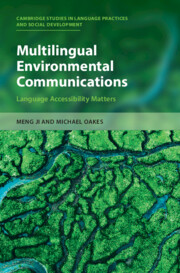Book contents
- Frontmatter
- Contents
- List of Figures
- List of Tables
- 1 Previous Research on Language Readability
- 2 Statistics and Machine Learning for Textual Readability Studies
- 3 Readability of Environmental Health Resources for Parental Education
- 4 Exploring the Suitability of Environmental Health Information for Parental Education Using Machine Learning Models
- 5 Improving the Readability of Japanese Translations of Natural Disaster Risks Through Predictive Automated English Information Design
- 6 Forecasting Mistakes in Machine Translation of Environmental Health Information to African Languages
- 7 Assessing Linguistic Accessibility of Chinese Environmental and Health Information
- 8 Conclusion
- Appendices
- References
- Index
1 - Previous Research on Language Readability
Published online by Cambridge University Press: 16 May 2025
- Frontmatter
- Contents
- List of Figures
- List of Tables
- 1 Previous Research on Language Readability
- 2 Statistics and Machine Learning for Textual Readability Studies
- 3 Readability of Environmental Health Resources for Parental Education
- 4 Exploring the Suitability of Environmental Health Information for Parental Education Using Machine Learning Models
- 5 Improving the Readability of Japanese Translations of Natural Disaster Risks Through Predictive Automated English Information Design
- 6 Forecasting Mistakes in Machine Translation of Environmental Health Information to African Languages
- 7 Assessing Linguistic Accessibility of Chinese Environmental and Health Information
- 8 Conclusion
- Appendices
- References
- Index
Summary
Readability assessment has been a key research area for the past 80 years, and still attracts researchers today. The most common measures currently (2011) in use are Flesch-Kincaid and Dale-Chall. Traditional models were parsimonious, incorporating as few linguistic features as possible, and used linear regression to combine two or three surface features. Later models used psychological theory, measuring such things as coherence, density, and inference load. A variety of machine learning models were used and one neural network. Key surface linguistic features were average syllables per word and sentence length. The Machine Learning methods performed well. Machine Learning methods can improve readability estimation. The process is data-driven, requiring less manual labour, and avoiding human bias. Current research seems to focus on deep learning methods, which show great promise.
Keywords
Information
- Type
- Chapter
- Information
- Multilingual Environmental CommunicationsLanguage Accessibility Matters, pp. 1 - 22Publisher: Cambridge University PressPrint publication year: 2025
